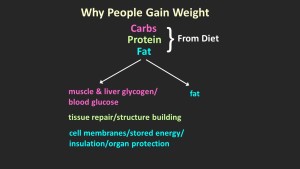A few years ago, I was standing in the diet and weight-loss book aisle of a bookstore, talking to a woman about losing weight. “I walk 2 miles a day 5 days a week,” she told me, “and I’m still not losing weight.” Sounding like she was frustrated, I tried to explain to her how many calories each mile of walking burns and the “calories out” part of the weight-loss equation. If I had had a pencil and piece of paper with me, I would have drawn her this diagram:
Following the left arrow in the diagram above and matching up the colors, you can see what carbohydrate, fat, and protein are used for in your body. Carbohydrate is used for fuel by your muscles and exists in your body in two forms: Glucose in your blood and glycogen (a branched chain of glucose molecules, which is the stored form of carbohydrate) in your muscles and liver. Any carbohydrate that you eat is used to replenish blood glucose and muscle and liver glycogen. Protein is used to build things like muscle tissue, enzymes, and other parts of cells that carry out specific functions. Fat is an important component of cell membranes and is used as a fuel, as insulation, and to protect your internal organs. Where things go awry is when you follow the right arrow in the diagram above. If your body doesn’t need to carry out the functions to the left, all of the extra calories from carbohydrate, fat, and protein follow the path of the right arrow and are stored as fat. The 2.1 billion people in the world who are overweight are overweight because the calories they consume follow the path of the right arrow. It’s as simple as that.
Your level of physical activity and your caloric intake are tightly coupled over a wide range of physical activities. However, this tight coupling is lost in people who don’t exercise at all, and caloric intake is inappropriately high, which causes people to gain weight.
The big secret to not gaining weight is to never go down the path of the right arrow. How do you do that? You must create an environment that forces the calories to follow the left arrow. How do you create such an environment? I’m glad you asked.
Running lowers your carbohydrate fuel tank, which creates a metabolic demand because carbohydrate is the muscles’ preferred fuel. Lowering that fuel tank is threatening to the survival of your muscles, so any carbohydrate you eat will be used to refill the tank. The synthesis and storage of glycogen—the refilling of the carbohydrate fuel tank—is controlled by the hormone insulin and the availability and uptake of glucose from the blood. Through its effect on specific proteins that transport glucose, insulin draws glucose from the blood into muscle cells to be stored. The glucose is then used to make new glycogen. The higher the blood insulin concentration and the greater the availability of glucose, the faster glycogen is synthesized and stored.
The same thing happens with protein. When you run, you send a signal to build structural and functional proteins and you cause microscopic damage to the muscle fibers, so the amino acids from any protein you eat will be used to build those structural and functional proteins and repair the damage to the muscle fibers to make them stronger and more durable.
To prevent fat from accumulating on those love handles, you must create a metabolic demand so that the calories are used for other, more important needs. Make the love handles wait. If you are always mobilizing energy for it to be used, you’re not storing it as fat. Running creates the metabolic demands, giving you the director’s clapperboard so that you decide where the calories go. And that is exactly one of the goals of the Run Your Fat Off program—to make you the director of the calorie movie, dictating where your calories go and how they are used.

